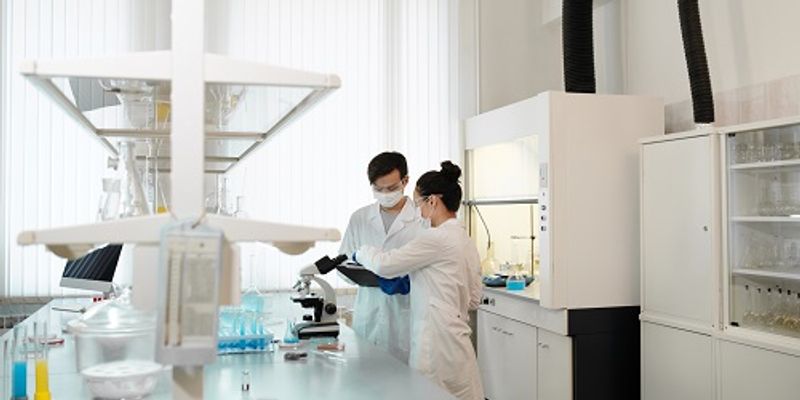Gene and Cell Therapy
With the goal of treating and curing disease, gene and cell therapy provide treatment by means of altering a person's genetic code and transferring live cells to improve symptoms and reduce levels of disease-causing proteins.
-
OCT 10, 2018 | 12:00 PMTo date the anatomic extent of tumor (TNM-classification) has been by far the most important factors to predict the prognosis of cancer patients. However, this classification provides limited...Speaker: Jerome Galon, PhDOCT 10, 2018 | 12:00 PMRNA sequencing unlocks the mysteries hidden in the transcriptome. Whether your goal is gene expression analysis, gene fusion analysis, SNP analysis or miRNA expression analysis, achieving hig...Speaker: Jonathan Shaffer, PhD, MBAOCT 10, 2018 | 10:30 AMThe microbiome signatures in the context of gynecologic cancers (endometrial and ovarian) and the potential for their clinical use will be discussed. The use of microfluidic technologies to i...Speaker: Marina Walther-Antonio, PhDOCT 10, 2018 | 10:30 AMPancreatic tumors are dynamic pseudo-organs that contain numerous cell types interacting to create unique physiology. A typical pancreatic tumor is made up largely of stromal fibroblasts and...Speaker: Costas A. Lyssiotis, PhDOCT 10, 2018 | 9:00 AMHigh-throughput screening is widely useful in identifying genes and pathways that drive changes in cell behavior such as cell cycle regulation, metastasis, and drug resistance. Millipor...Speaker: Andrew Ravanelli, PhDOCT 10, 2018 | 9:00 AMIn prior work, we have pursued how tumor reactive monoclonal antibody (mAb), together with activators of innate immune cells, like NK cells, can augment antibody dependent cell-mediated cytot...Speaker: Paul Sondel, MD, PhDOCT 10, 2018 | 7:30 AMMolecular analyses of cancer biology have tended to segregate between a focus on nucleic acids – DNA, RNA and their modifications – and a focus on proteins and protein function. P...Speaker: Karin Rodland, PhDOCT 10, 2018 | 6:00 AMUnderstanding the immune repertoire is an important aspect of immuno-oncology research, which can be used to gather insights into the function and overall status of the immune system. We have...Speaker: Samuel Rulli, PhDOCT 10, 2018 | 6:00 AMWith over 265,000 new cases per year and over 50,000 deaths, breast and ovarian cancers represent a significant health burden in the USA. Prior work has demonstrated that CD4 helper T c...Speaker: Keith Knutson, PhDOCT 09, 2018 | 8:00 AMDATE: October 9, 2018TIME: 08:00am PDT, 11:00pm EDT Have you ever wondered what to consider when you are selecting ancillary materials for your cell therapy clinical research...OCT 03, 2018 | 12:00 PMDecoding human genetic disease allows us to develop models of the pathology that can be directly tested with gene correction or targeted drug therapy. Dominant negative mutations are pa...OCT 03, 2018 | 12:00 PMAll forms of life require immune systems to stave off infection from viruses and other pathogens. In bacteria and archaea, clustered regularly interspaced short palindromic repeats (CRISPR) a...OCT 03, 2018 | 10:30 AMThere have been an increasing number of successful human gene therapy clinical trials, and in particular gene delivery vehicles or vectors based on the adeno-associated virus (AAV) have enabl...OCT 03, 2018 | 9:00 AMThe most recently developed genome editing system, CRISPR-Cas9 has greater inherent flexibility than prior programmable nuclease platforms. Because of its simplicity and efficacy, this techno...OCT 03, 2018 | 9:00 AMLearn how to optimize CRISPR-Cas9 editing efficiencies in cell lines and primary cell types using modified synthetic sgRNA. Includes tips for achieving maximum knockout and knock-in efficienc...OCT 03, 2018 | 7:30 AMThe National Institute of Standards and Technology (NIST), is the measurement institute of the U.S., supplying unbiased expertise in measurements and standards to support growth in all sector...OCT 03, 2018 | 6:00 AMThe CRISPR-Cas9 system has proven to be a powerful tool for genome editing allowing for the precise modification of specific DNA sequences within a cell. Many efforts are currently underway t...OCT 01, 2018 | 12:00 AMPancreatic β cell replacement therapy is considered as a potential strategy to treat diabetes. To date, transplantation of pancreatic islets from cadavers is the most effective approach...SEP 27, 2018 | 12:00 PMThere is considerable excitement surrounding the treatment potential of T cell immunotherapies. Amongst these, CAR-T cells have demonstrated impressive therapeutic efficacy in a subset of hem...SEP 18, 2018 | 8:00 AMDATE: September 18,2018TIME: 08:00am PDT, 11:00am EDT CRISPR-Cas9 gene editing strategies have revolutionized our ability to engineer the genomes of diverse cell types and sp...SEP 18, 2018 | 5:00 AMTo ensure the immune system’s balance between the recognition of non-self and the prevention of autoimmunity, the activity of immune cells needs to be strictly controlled. During the pr...SEP 13, 2018 | 1:30 PMThe soil microbiome can produce, resist, or degrade antibiotics and even catabolize them. Resistance genes are widely distributed in the soil and may act as a reservoir for pathogen antibioti...SEP 01, 2018 | 8:00 AMDelicate cultures including stem cells and primary cells are increasingly used in cell therapy research and development for applications in oncology, immunology, neurology and more. Commonly,...AUG 15, 2018 | 8:00 AMDATE: August 15, 2018TIME: 08:00AM PDT, 11:00AM EDTThe failure of current chemotherapeutic strategies in the fight against cancer can be largely attributed to the occurrence of drug res...
OCT 10, 2018 | 12:00 PM
To date the anatomic extent of tumor (TNM-classification) has been by far the most important factors to predict the prognosis of cancer patients. However, this classification provides limited...
Speaker:
Jerome Galon, PhD
OCT 10, 2018 | 12:00 PM
RNA sequencing unlocks the mysteries hidden in the transcriptome. Whether your goal is gene expression analysis, gene fusion analysis, SNP analysis or miRNA expression analysis, achieving hig...
Speaker:
Jonathan Shaffer, PhD, MBA
OCT 10, 2018 | 10:30 AM
The microbiome signatures in the context of gynecologic cancers (endometrial and ovarian) and the potential for their clinical use will be discussed. The use of microfluidic technologies to i...
Speaker:
Marina Walther-Antonio, PhD
OCT 10, 2018 | 10:30 AM
Pancreatic tumors are dynamic pseudo-organs that contain numerous cell types interacting to create unique physiology. A typical pancreatic tumor is made up largely of stromal fibroblasts and...
Speaker:
Costas A. Lyssiotis, PhD
OCT 10, 2018 | 9:00 AM
High-throughput screening is widely useful in identifying genes and pathways that drive changes in cell behavior such as cell cycle regulation, metastasis, and drug resistance. Millipor...
Speaker:
Andrew Ravanelli, PhD
OCT 10, 2018 | 9:00 AM
In prior work, we have pursued how tumor reactive monoclonal antibody (mAb), together with activators of innate immune cells, like NK cells, can augment antibody dependent cell-mediated cytot...
Speaker:
Paul Sondel, MD, PhD
OCT 10, 2018 | 7:30 AM
Molecular analyses of cancer biology have tended to segregate between a focus on nucleic acids – DNA, RNA and their modifications – and a focus on proteins and protein function. P...
Speaker:
Karin Rodland, PhD
OCT 10, 2018 | 6:00 AM
Understanding the immune repertoire is an important aspect of immuno-oncology research, which can be used to gather insights into the function and overall status of the immune system. We have...
Speaker:
Samuel Rulli, PhD
OCT 10, 2018 | 6:00 AM
With over 265,000 new cases per year and over 50,000 deaths, breast and ovarian cancers represent a significant health burden in the USA. Prior work has demonstrated that CD4 helper T c...
Speaker:
Keith Knutson, PhD
OCT 09, 2018 | 8:00 AM
DATE: October 9, 2018TIME: 08:00am PDT, 11:00pm EDT Have you ever wondered what to consider when you are selecting ancillary materials for your cell therapy clinical research...
OCT 03, 2018 | 12:00 PM
Decoding human genetic disease allows us to develop models of the pathology that can be directly tested with gene correction or targeted drug therapy. Dominant negative mutations are pa...
OCT 03, 2018 | 12:00 PM
All forms of life require immune systems to stave off infection from viruses and other pathogens. In bacteria and archaea, clustered regularly interspaced short palindromic repeats (CRISPR) a...
OCT 03, 2018 | 10:30 AM
There have been an increasing number of successful human gene therapy clinical trials, and in particular gene delivery vehicles or vectors based on the adeno-associated virus (AAV) have enabl...
OCT 03, 2018 | 9:00 AM
The most recently developed genome editing system, CRISPR-Cas9 has greater inherent flexibility than prior programmable nuclease platforms. Because of its simplicity and efficacy, this techno...
OCT 03, 2018 | 9:00 AM
Learn how to optimize CRISPR-Cas9 editing efficiencies in cell lines and primary cell types using modified synthetic sgRNA. Includes tips for achieving maximum knockout and knock-in efficienc...
OCT 03, 2018 | 7:30 AM
The National Institute of Standards and Technology (NIST), is the measurement institute of the U.S., supplying unbiased expertise in measurements and standards to support growth in all sector...
OCT 03, 2018 | 6:00 AM
The CRISPR-Cas9 system has proven to be a powerful tool for genome editing allowing for the precise modification of specific DNA sequences within a cell. Many efforts are currently underway t...
OCT 01, 2018 | 12:00 AM
Pancreatic β cell replacement therapy is considered as a potential strategy to treat diabetes. To date, transplantation of pancreatic islets from cadavers is the most effective approach...
SEP 27, 2018 | 12:00 PM
There is considerable excitement surrounding the treatment potential of T cell immunotherapies. Amongst these, CAR-T cells have demonstrated impressive therapeutic efficacy in a subset of hem...
SEP 18, 2018 | 8:00 AM
DATE: September 18,2018TIME: 08:00am PDT, 11:00am EDT CRISPR-Cas9 gene editing strategies have revolutionized our ability to engineer the genomes of diverse cell types and sp...
SEP 18, 2018 | 5:00 AM
To ensure the immune system’s balance between the recognition of non-self and the prevention of autoimmunity, the activity of immune cells needs to be strictly controlled. During the pr...
SEP 13, 2018 | 1:30 PM
The soil microbiome can produce, resist, or degrade antibiotics and even catabolize them. Resistance genes are widely distributed in the soil and may act as a reservoir for pathogen antibioti...
SEP 01, 2018 | 8:00 AM
Delicate cultures including stem cells and primary cells are increasingly used in cell therapy research and development for applications in oncology, immunology, neurology and more. Commonly,...
AUG 15, 2018 | 8:00 AM
DATE: August 15, 2018TIME: 08:00AM PDT, 11:00AM EDTThe failure of current chemotherapeutic strategies in the fight against cancer can be largely attributed to the occurrence of drug res...
























